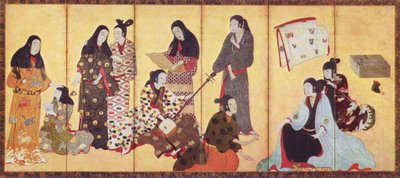at the time of shakespeare
 this screen, credited to matahei by ernest fenollosa was considered a national treasure and was sent to the exhibition of 1900 in paris by the japanese government.
this screen, credited to matahei by ernest fenollosa was considered a national treasure and was sent to the exhibition of 1900 in paris by the japanese government.fenollosa was a friend of morse's and was called to japan by him. in 1911 he wrote about the screen in epochs of chinese and japaense art. more about him later, but i think his descriptions of the 'hikone screen' illuminate the screen as well as the culture as much as its background of gold.
"[the screen] represents graceful figures of men and girls and children in rich colors upon a gold ground, seated upon the mats in utterly unrestrained japanese attitudes. in the center of one screen an old blind musician is giving a lesson in samisen-playing to two girls, while a party of young people nearby play a game of go. behind those two groups a beautiful landscape screen, evidently by kano motonobu, is unfolded. another group shows us all slender girls walking, while a gay young samurai leans in a most unconventional attitude upon his long sword. this shows us a tendency to dissipation that may well become the degeneration of the whole buke class*, if not checked...."
two more gold-backed screens by this artist are known.

fenollosa places all of these works in the early 1600s, about when shakespeare was working continents away.
i believe it is of someone in these two that fenollosa says, "...the lines of the young girl seated upon the bench with withdrawn knees are among the most graceful in all japanese art."
some credit matahei with having been the founder of the ukiyo-e school of painting, but some credit others. this kind of thing happens a lot.

* he was right. the bukes were the samurai.
Labels: iwasa matabei


0 Comments:
Post a Comment
hi, and thanks so much for stopping by. i spend all too much time thinking my own thoughts about this stuff, so please tell me yours. i thrive on the exchange!
<< Home